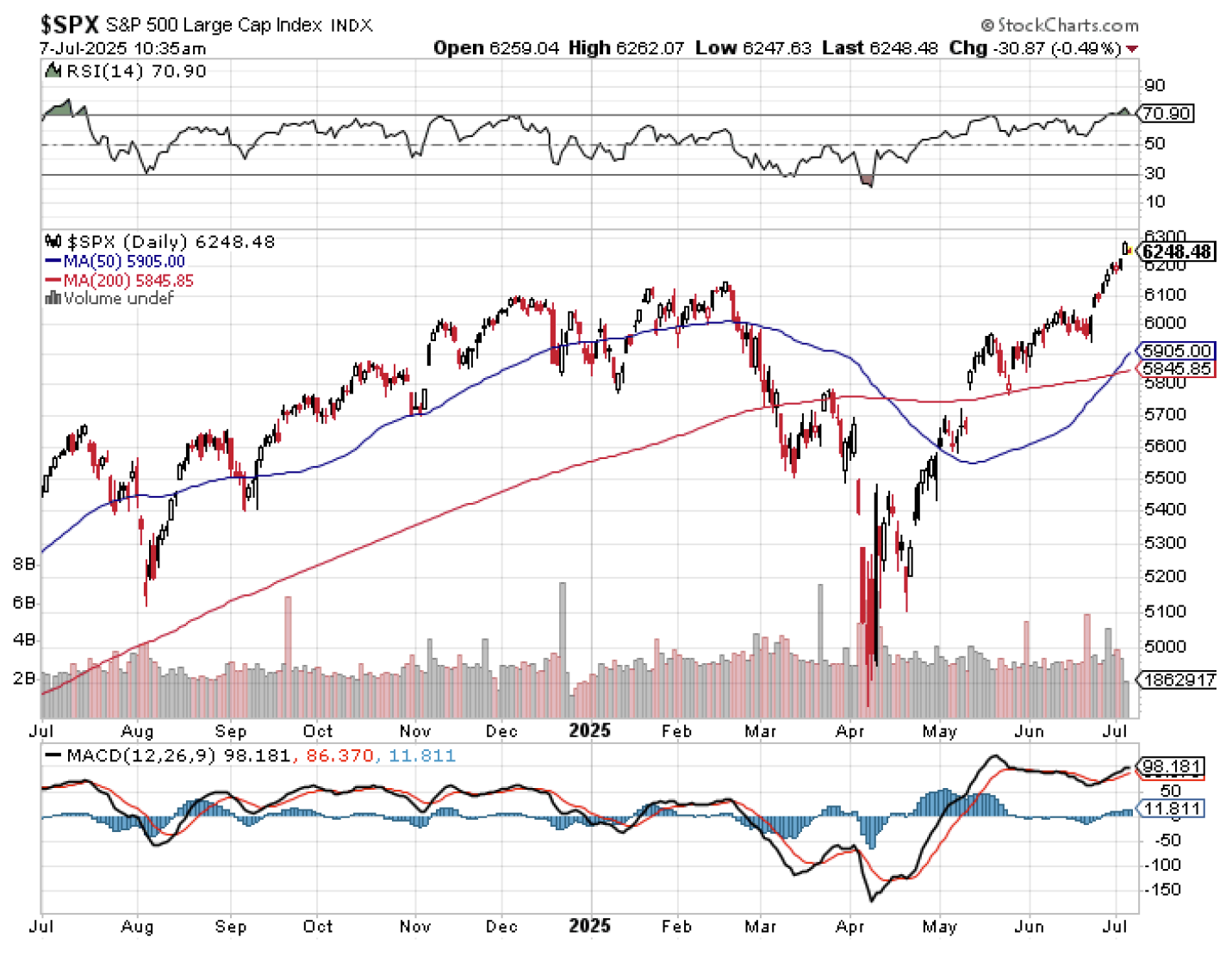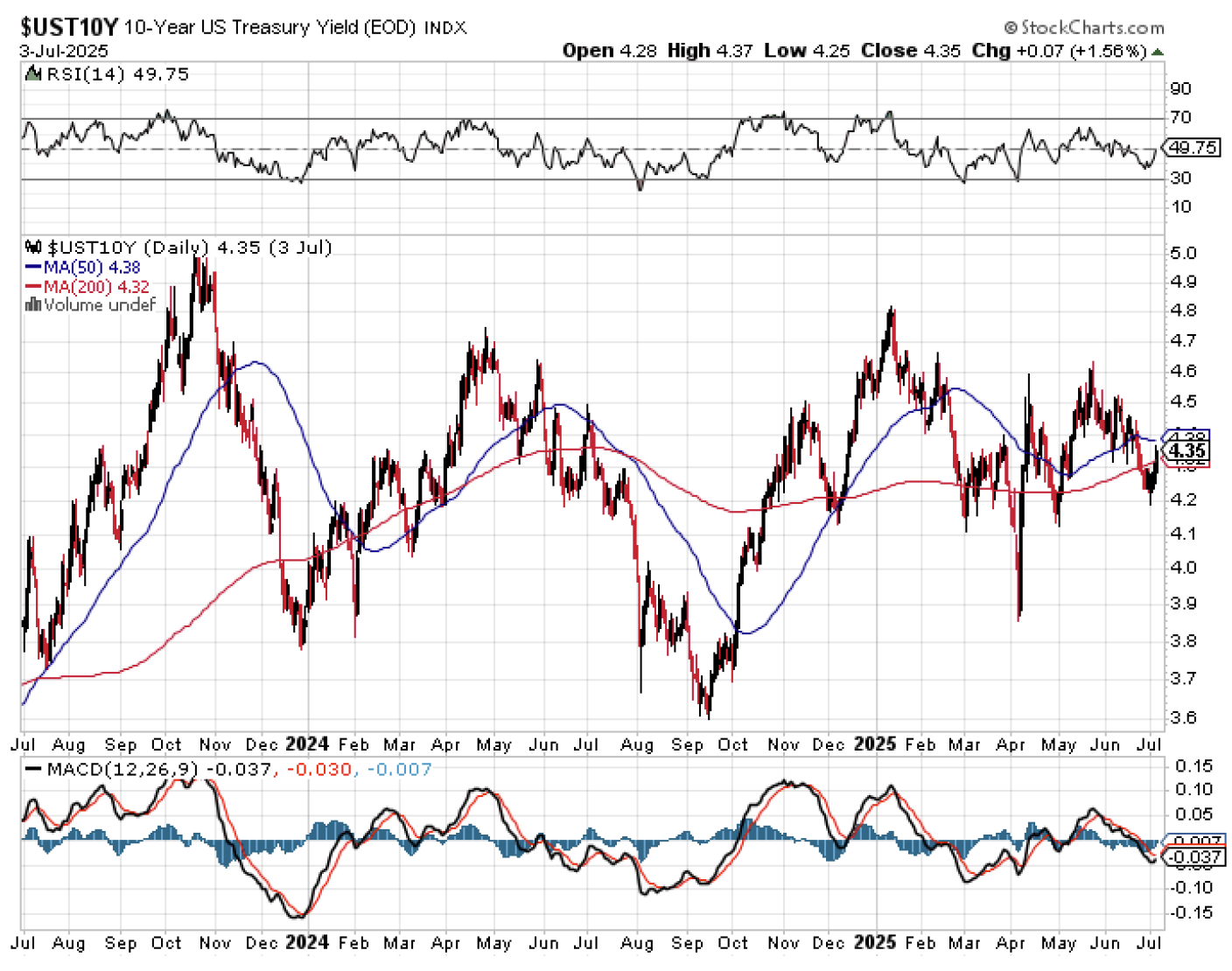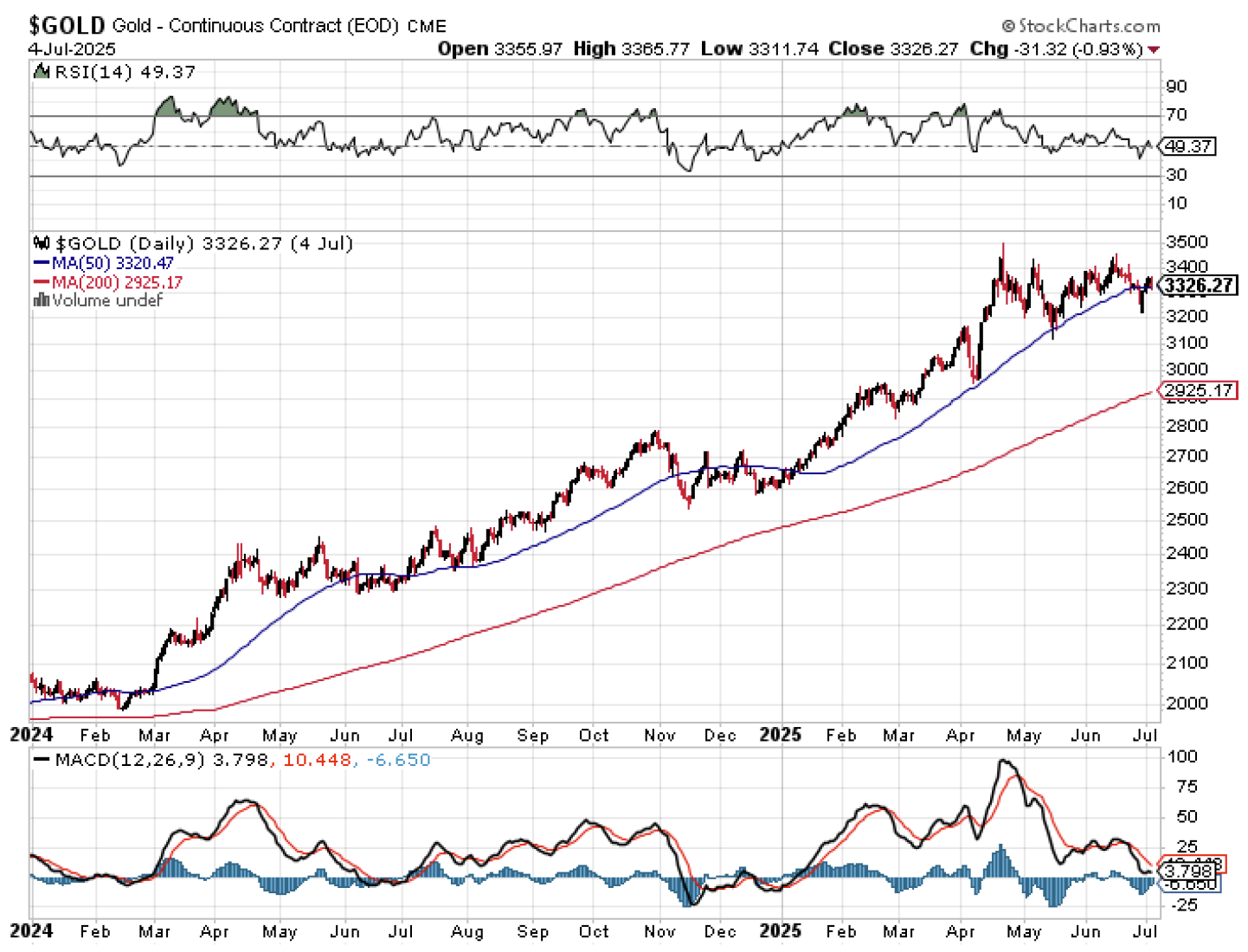
2025 Second Half Outlook
The second half of 2025 is underway. And now that we’ve enjoyed our final Fourth of July festivities before the big Bisesquicentennial celebrations next year (250 years is hard to believe – I can still remember standing on the side of the road in back in 1976 watching the Bicentennial Wagon Train Pilgrimage roll by as it wrapped up its trip across the country to Valley Forge – apparently I’ve aged a bit since then), it’s a good time to reengage with the markets and what we can expect through the remainder of the year.
U.S. stocks – BULLISH. Let’s get right to the good stuff. Barring the unexpected idiosyncratic and/or exogenous event happening along the way, the U.S. stock market as measured by the S&P 500 is set to move higher in the second half of 2025. Why? The U.S. economy remains resilient with Real GDP growth projected to continue at 2% or better through the third quarter. Yes, some are projecting U.S. economic growth will start to fade in 2025 Q4 with forecasts dipping into the 1% range, but it’s important to note that blue chip economists have been calling for an economic slowdown going all the way back to 2022 and it just keeps not happening. And instead of relying on the cloudy crystal balls of the various hit-or-miss economists, I prefer to continue to refer back to the collective earnings forecasts of the 500 companies (pretty good sample size as statistical samples go) that continue to project earnings growth in the range of +12% to +15% through 2026 Q1 tariffs be damned. With inflation expectations still firmly in check – repeat, tariffs be damned! – we have a tasty recipe for continued stock market gains (valuations be damned too! – sure stocks are salty to say the least at more than 28 times earnings, but history has shown that frothy valuations do not matter until they matter a lot, but this is typically when corporate earnings decline and the economy falls into recession, and neither of these conditions are imminent today).
Before we go any further, it is important to caveat this bullish stock market outlook for the remainder of 2025. This is a six-month projection, but we must remember that stocks typically move in a “three steps forward, one step back” pattern. And where we stand today after a phenomenal upside burst to end a phenomenal quarter (particularly if you exclude the first five trading days in April) is an S&P 500 that is now well overdue for a measurable “one step back” pullback. This is evidenced in the chart below, as the S&P 500 is trading well above its short-term 20-day (green dashed line), medium-term 50-day (blue line), long-term 200-day (red line), and ultra long-term 400-day (pink line) moving averages at the same time that its Relative Strength Index is reading nearly 76 (anything over 70 means a pullback is overdue). As a result, we should not be surprised to see the S&P 500 fall back anywhere between -3% to -7% starting any day now, and this would be totally normal and healthy in the context of the continued ongoing uptrend in stocks dating back to October 2022.
Beyond any short-term pullback and focusing on the longer-term market trend given the underlying positive fundamental backdrop, we should not be surprised at all to see the S&P 500 trading in the 6500 to 6700 range by the end of 2025, which is +4% to +7% higher than where it closed on Friday. Will tech continue to lead the charge? Potentially, but don’t be surprised if many of the other sectors increasingly join in on the upside as the year progresses. For as expensive as the broader market may be, the sectors that are not tech or tech adjacent (communication services, consumer discretionary) are trading at historically discounted valuations in many cases.
U.S. bonds – NEUTRAL. I love the bond market. In fact, I find it more interesting than the stock market – so much bigger with so many differentiated categories and sub-categories. The bond market is a bad a$$ too – want to get the President to knock it off on tariffs? Call on the bond market. Want to start a financial crisis? Bond market once again. It is also has a great long term history of portfolio diversification given its low correlation with the stock market (assuming inflation is in check, of course).
But with all of this being said, the outlook for U.S. bonds is neutral at best for the remainder of 2025. Not that it’s bad, but it’s not great either. Why? First, it’s important to note that the four-decade long bull market in bonds from 1981 to 2021 is now officially over. Forty years is a phenomenal run, but you gotta expect some consolidation is going to play out at least for the next few years in the aftermath. This is particular true given that inflation, while currently under control, is still sticking higher than it had been from 2008 to 2021 in the aftermath of the Great Financial Crisis in a world drifting toward disglobalization/deglobalization and onshoring of production. And given that the just passed Federal budget contains a lil bit of deficit spending over the next several years, these are the types of things that are not only economically stimulative (marginally bearish for bonds) but also weaken domestic fiscal health (marginally bearish for bonds) and potentially lead to higher borrowing costs (plainly bearish for bonds – as yields rise, bond prices fall).
Putting this all together, expect U.S. Treasuries to continue to oscillate in its 3.75% to 4.75% trading range on the 10-year for the remainder of the year just as it has since the summer 2023. If concerns about the economy slowing finally end up manifesting, expect yields to drift to the low end of this range. Conversely, if the economy accelerates more quickly than expected and brings inflationary pressures along with it, expect yields to push toward the high end of the range if not beyond. Overall, risks for the bond market are marginally tilted to the downside (higher yields). Nonetheless, bonds continue to offer attractive interest income north of 4% for prime quality lending, particularly for those that are inclined to operate on the shorter duration side of the market.
Commodities. Only the facts here. Let’s start with precious metals. Gold has been on a tear for years now, having more than doubled since the October 2022 low in stocks. And since the start of 2024, gold has been very well behaved from a technical price perspective, finding consistent, repeated, and steady support at its 50-day moving average (blue line in chart below). At present, it is trading right at this technical support level, and the trend remains definitely to the upside to date.
As for the rest of the commodities complex, it remains a mixed bag. Dr. Copper is trading at all-time highs – good classic predictor for the overall health of the economy, while coffee and cocoa have recently backed off scorchingly high prices. For all of the fuss about not being able to get a deck built during COVID, lumber prices have been back down to 2018 levels for some time. As for oil, it is still trading below 2006 levels even after the Israeli attack on Iran, hence the cost we pay at the pump for a gallon of gas is about the same as it was twenty years ago. Sugar? Trading today below levels first reached in 1990. Cotton? Less today than it cost back in the early 1980s. Why rattle off all of these commodities? Because if the prices for most if not nearly all of our raw materials are the same as they were twenty, thirty, forty years ago or more, it provides further confirmation that inflation pressures remain solidly in check despite understandable concerns otherwise.
Bottom line. The second half of the year is underway, and the outlook for stocks beyond an overdue short-term pullback is favorable through the rest of 2025. The outlook for bonds is choppier, but is an asset class that is still well positioned do its diversifying, income producing job. As for the commodities space, the rise in gold has been steady and well behaved from a technical perspective.
We wish you all a safe and prosperous second half of the calendar year!
Disclosure: I/we have no stock, option or similar derivative position in any of the companies mentioned, and no plans to initiate any such positions within the next 72 hours. I wrote this article myself, and it expresses my own opinions. I am not receiving compensation for it. I have no business relationship with any company whose stock is mentioned in this article.
Investment advice offered through Great Valley Advisor Group (GVA), a Registered Investment Advisor. I am solely an investment advisor representative of Great Valley Advisor Group, and not affiliated with LPL Financial. Any opinions or views expressed by me are not those of LPL Financial. This is not intended to be used as tax or legal advice. All performance referenced is historical and is no guarantee of future results. All indices are unmanaged and may not be invested into directly. Please consult a tax or legal professional for specific information and advice.
LPL Compliance Tracking #: 765054



